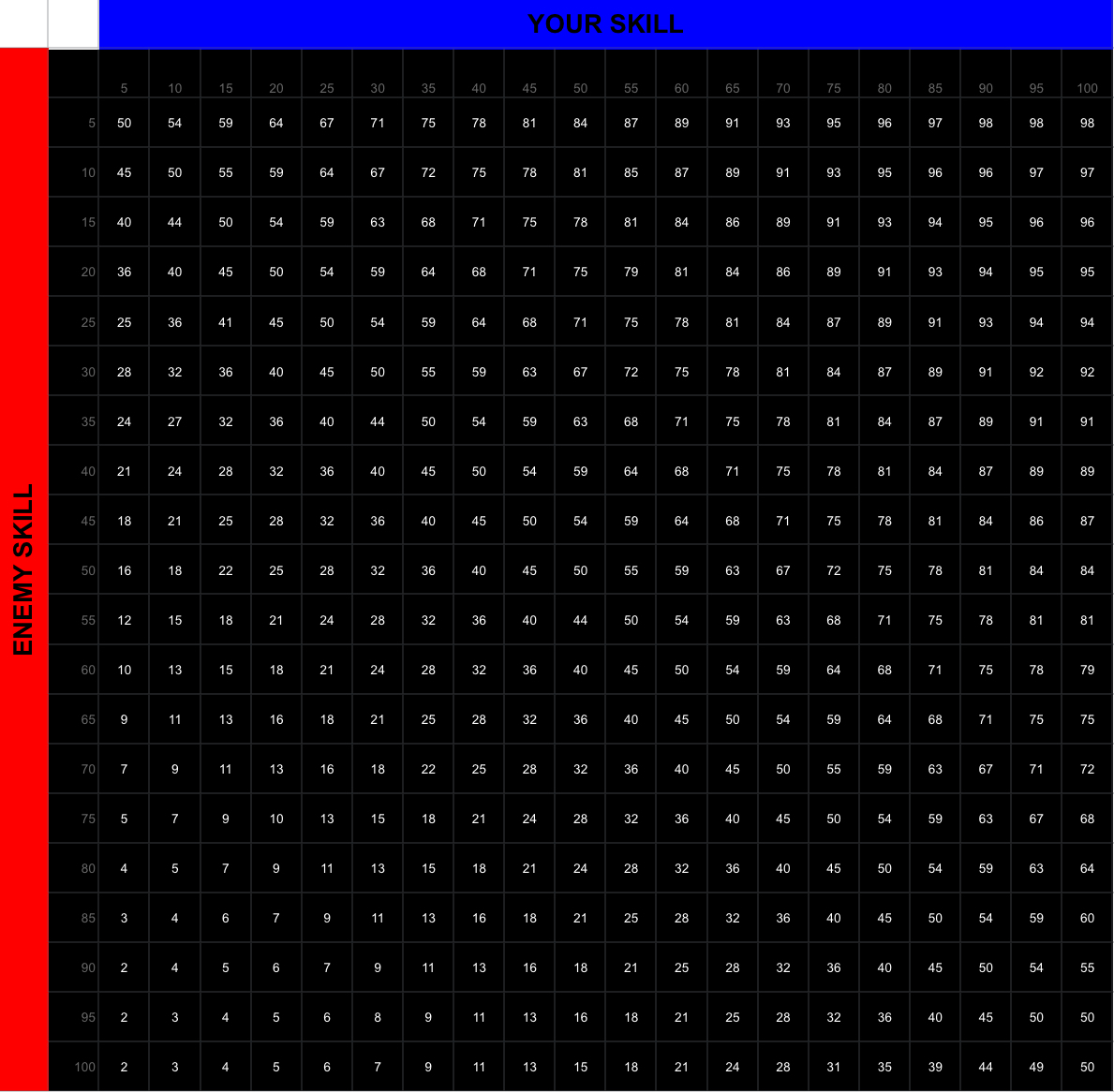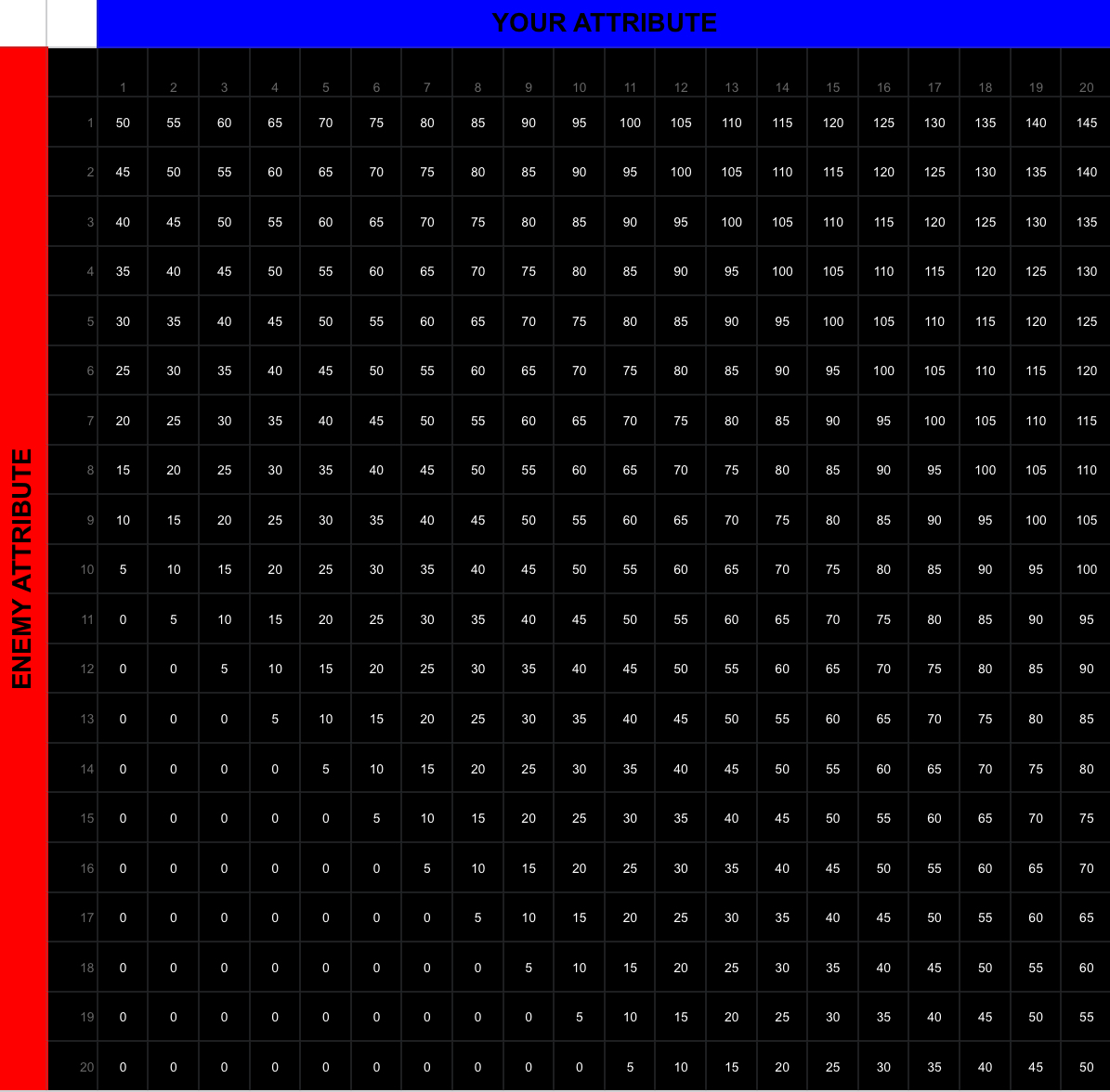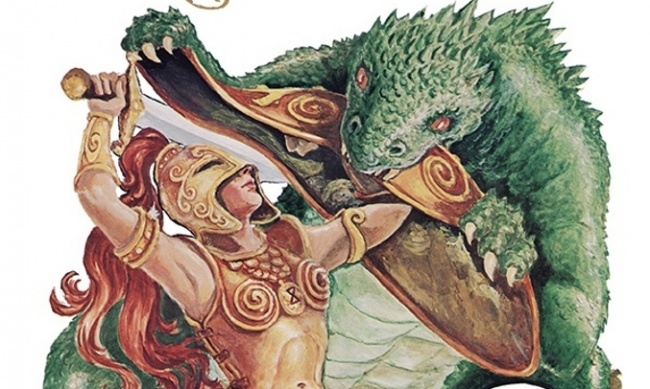I wanted to post up some probabilities for Runequest: Roleplaying in Glorantha. After I asked on Discord, Tommi generously crunched the numbers for me. You can view the spreadsheet he built (and lots of other game-related stuff) at his blog.
As background, there are two methods of opposed rolls in RQG. The first is to match a character’s Characteristic (STR, DEX, etc.) against the Characteristic of an opposing force (the SIZ of an object they’re trying to move, the POT of a poison they’re trying to resist, etc.)
Characteristics are compared on the Resistance table to find a probability of success, the ‘active’ character rolls, and if they roll under they overcome the resistance of the opposing force and win (lift the boulder, shake off the poison, etc.)

The second method is an Opposed Skill contest. Each character rolls against their Skill independently and checks to see if they achieved a Fumble, Failure, Success, Special Success or Critical. The character with the higher type of success wins, and in case both achieve the same kind of success, the character who rolled higher wins.
The question I wanted to answer by looking at probabilities for Opposed Skill contests was how interchangeable Opposed Skill rolls were with the Resistance Table (and, by extension, how interchangeable Skills are with Characteristics).
Take for example a contest between a Skill of 75% and a Skill of 45%. Would the probability of success for the character with 75% be the same as if we’d converted the Skills into Characteristics (75% / 5 = 15 and 45% / 5 = 9) and compared them on the Resistance Table?

As you can see, the probabilities for Opposed Skill contests are significantly different from the Resistance Table, particularly where the differences are large. The example above (Characteristic of 15 vs Characteristic of 9) yields an 80% probability of success on the Resistance Table, whereas treated as an Opposed Skill roll (75% vs 45%) it yields a 75% probability of success, to say nothing of the added textures of having both participants’ rolls output a result (both succeed, both fail, one attains Special Success while one Fumbles, etc.)
I don’t want to speculate much on how these differences impact play. The only thing that seems immediately noteworthy is that a Skill or Passion augment is hugely impactful when used on the Resistance Table–on a regular success or failure, you’re looking at +/- 20%, the equivalent of 4 Characteristics points! And this can easily (if temporarily) push a character over the usual limits of their species maximum.
Augments of Opposed Skill rolls, by comparison, have a smaller impact (a 20% shift on a skill our 75% skill only increases the chance of success by 11% on a regular success or decreases it by 16% on a failure).
I’d love to hear others’ observations of these differing systems, and I’d be especially curious to hear how different tables have used the Resistance Table in play. I have this sense that the Resistance Table can be used to make the immediate terrain (boulders, thickets, waterfalls) interactive and tangible. But I haven’t seen it realized in play yet.


5 responses to “Characteristics vs Skills”
They Are Modeling Different Things
But first… I do think you COULD play with only the Resistance table. Use skills as Ausgments to the appropriate resistance, maybe giving a +2 bonus on the Characteristic for the resistance roll if they succeed at the augment roll.
Characteristics and Skills are meant to model different things. In the skills, the possibility exists that both will succeed and the entire thing might be a push, with no advantage gained. Using characteristics, the model is more "if we did this thing ten times, the higher characteristic will win X number of times". The entire outcome is resolved with resistance, where a skill check is just determining a discrete outcome, no resolving a sword fight, for example.
Hey there Sean! Nice to touch
Hey there Sean! Nice to touch base again—your responses to my first RQG post last year really fired my determination to get this game to the table.
Quick sidebar on rules interpretations: it is my understanding that, while Opposed rolls might lead to draws in specific subsystems (e.g., strike/parry), draws will be pretty rare in general. If both characters succeed with the same quality of success on a regular Opposed Skill roll, the one who rolls higher on their d100 is considered to have 'won.' Even under this interpretation, though, I think your point holds that both characters can succeed, fail, REALLY fail, etc., with one just succeeding slightly better or failing slightly worse.
HOWEVER, what I'd really love to hear about are specific fictional situations where you've successfully used the Resistance Table (as opposed to an un/opposed Skill check). I can almost see what you mean by the R-Table applying to situations where "if we did this thing ten times, the higher characteristic will win X number of times," but not quite.
I guess what I'm seeing is that Opposed Skill rolls have more fictional input. That is, each character is rolling against their own ability. Within each check, adversity is represented by the ability's distance from 100% (with a 75%, things aren't going to go your way 25% of the time). So you have two attempts, two adversities, and an outcome based on their comparison. I think specific examples/cases would help me understand (if you have the time and inclination!)
Noah – I have been enjoying
Noah – I have been enjoying reading the actual plays for your RQ games. I'm glad you were inspired to continue.
I think that the Resistance table offers a more streamlined means of resolution and far less whiff factor. And because it requires one roll, it can be used to resolve an entire battle or a a single exchange between two opponents. And fictional input can be added to the end, with the winning character controlling the narrative. You can also reproduce a full exchange, instead of attack – parry attack – parry from each participant.
Elg is attacking a broo. Both are using melee combat so use the STR characteristic OR an average of STR – SIZ – DEX to get a characteristic number. Let's say Elg has the 15 and the broo has a 9. You can do this two ways.
First, blow-by-blow. On the lowest SR (Elg or the broo) they engage in combat. Have Elg roll and if they roll lower than the 80%, Elg wins and rolls damage. If Elg fails, the broo wins and rolls damage. Whichever won the exchange narrates the outcome, based on their respective "skill".
Second, drifting towards Herowars, the single Resistance roll decides the entire combat. The winner defeats the loser, with Elg's player rolling. Perhaps if they roll in critical ranges (01-05 or 96-100) the loser is killed or maimed.
In both cases, skills could be used to Augment the roll. Each would roll their weapon skill before the % are decided. A success means adding +2 to the base characteristic, which figures into the resistance roll.
I am glad to hear you’re
I am glad to hear you're enjoying the posts. I'm hoping to catch my reports up to where we're at in actual play soon.
That is an interesting approach to the Resistance Table! It's cool to see how these concepts from all the way in RQ2 evolve into Pendragon's Opposed Skills, Hero Wars' Contests, then get 'ported back' into a refined RQ2 framework. At this point, I honestly cannot imagine abstracting RQG combat into a single roll like that, but I could also see (in certain situations over long-term play) how that might be desirable. BW has Bloody Versus as an alternative for Fight! for a reason, right?
A Seminar partner post
Noah and I talked about this based on his earlier play-posts, so it's a parallel partner to this one: Probabilities and RQG. Enjoy!